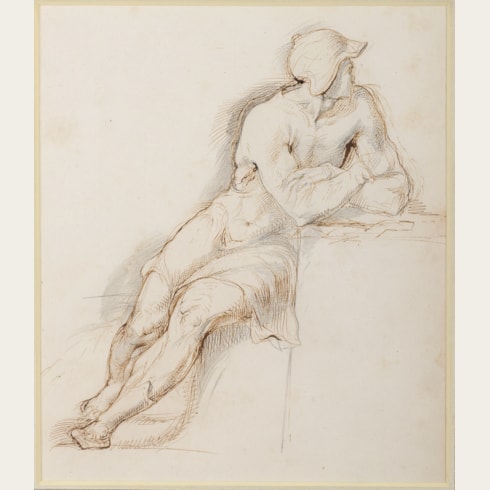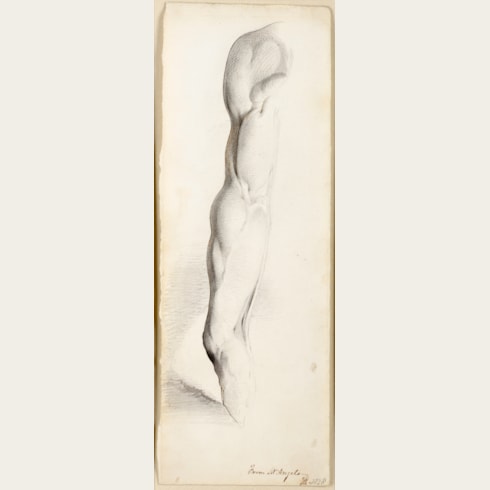George RICHMOND
(Brompton 1809 - London 1896)
Self-Portrait in Profile
Sold
Pen and brown ink, with touches of pink wash, over traces of an underdrawing in pencil, on a page from a sketchbook.
A sketch of the legs of a standing figure drawn in pencil on the verso.
130 x 196 mm. (5 1/8 x 7 3/4 in.)
A sketch of the legs of a standing figure drawn in pencil on the verso.
130 x 196 mm. (5 1/8 x 7 3/4 in.)
Like much of George Richmond’s oeuvre of drawings and watercolours, this striking self-portrait study, which may be dated to the 1830s, remained in the possession of his descendants, and largely unknown to scholars, until recently. As Susan Sloman has noted of the present sheet, ‘Richmond was an enthusiastic and regular observer of his own features, painting several oil self-portraits in a distinctly Reynolds-inspired style…There are strong similarities between this drawing and other likenesses of the artist. He wore his hair this length throughout his life, deliberately covering his large ears, and his long nose and deep-set eyes are clearly defined in other drawn and painted self-portraits. A profile relief portrait of the artist made for his memorial in the crypt of St. Paul’s Cathedral by his son William Blake Richmond shares all the features seen here.’
Among other early self portraits by George Richmond is an oval miniature of c.1831 in the National Portrait Gallery in London. Further self portraits by the artist are today in the collections of the Birmingham Museum and Art Gallery, the Fitzwilliam Museum in Cambridge, the Uffizi in Florence, the National Portrait Gallery in London and the Yale Center for British Art in New Haven.
Among other early self portraits by George Richmond is an oval miniature of c.1831 in the National Portrait Gallery in London. Further self portraits by the artist are today in the collections of the Birmingham Museum and Art Gallery, the Fitzwilliam Museum in Cambridge, the Uffizi in Florence, the National Portrait Gallery in London and the Yale Center for British Art in New Haven.
A disciple of Willam Blake and a close friend of Samuel Palmer, George Richmond formed - with Palmer, Edward Calvert and other followers of Blake - a small group who called themselves ‘The Ancients’. The only member of ‘The Ancients’ who received a conventional academic training, Richmond entered the Royal Academy Schools in December 1824, at the age of just fourteen, and there studied under Henry Fuseli. It was while he was at the Academy Schools that he first showed himself to be an accomplished and gifted draughtsman. Between 1824 and 1828 Richmond often joined Blake, Palmer, John Varley and others at John Linnell’s Hampstead home to draw from nature, as he also did with Palmer at Shoreham in Kent for several weeks in 1827. After his marriage in 1831, Richmond began working primarily as a portrait painter, quickly achieving a considerable measure of success. Although much influenced by Michelangelo and Italian art of the Renaissance, it was not until 1838 that Richmond was able to visit Italy, when he travelled with Palmer to Rome. In the 1840s he became friendly with John Ruskin, of whom he produced two portraits, exhibited at the Royal Academy in 1843 and 1857; the second of these was later engraved. Elected to the Royal Academy in 1866, Richmond’s stature in the London art world was such that he was twice offered the directorship of the National Gallery, which he twice declined. It is as a portraitist that Richmond is best known today, and which accounts for the bulk of his extant oeuvre as a painter. As his biographer Raymond Lister has noted, ‘Richmond was in fact at his greatest as a portrait painter. Despite yearnings to express himself in other ways, despite his early promise as a visionary painter, it is in portraiture that his true stature is to be seen.’
Provenance
By descent in the family of the artist, until 2001
Christopher Powney, London;
Thence by descent to a private collection.
Christopher Powney, London;
Thence by descent to a private collection.
Literature
Susan Sloman, Missing Pages. George Richmond R.A. 1809-1896: Drawings, Watercolours, Letters, Journals & Notebooks, exhibition catalogue, London, 2001, unpaginated, no.17, illustrated pl.XIII.








